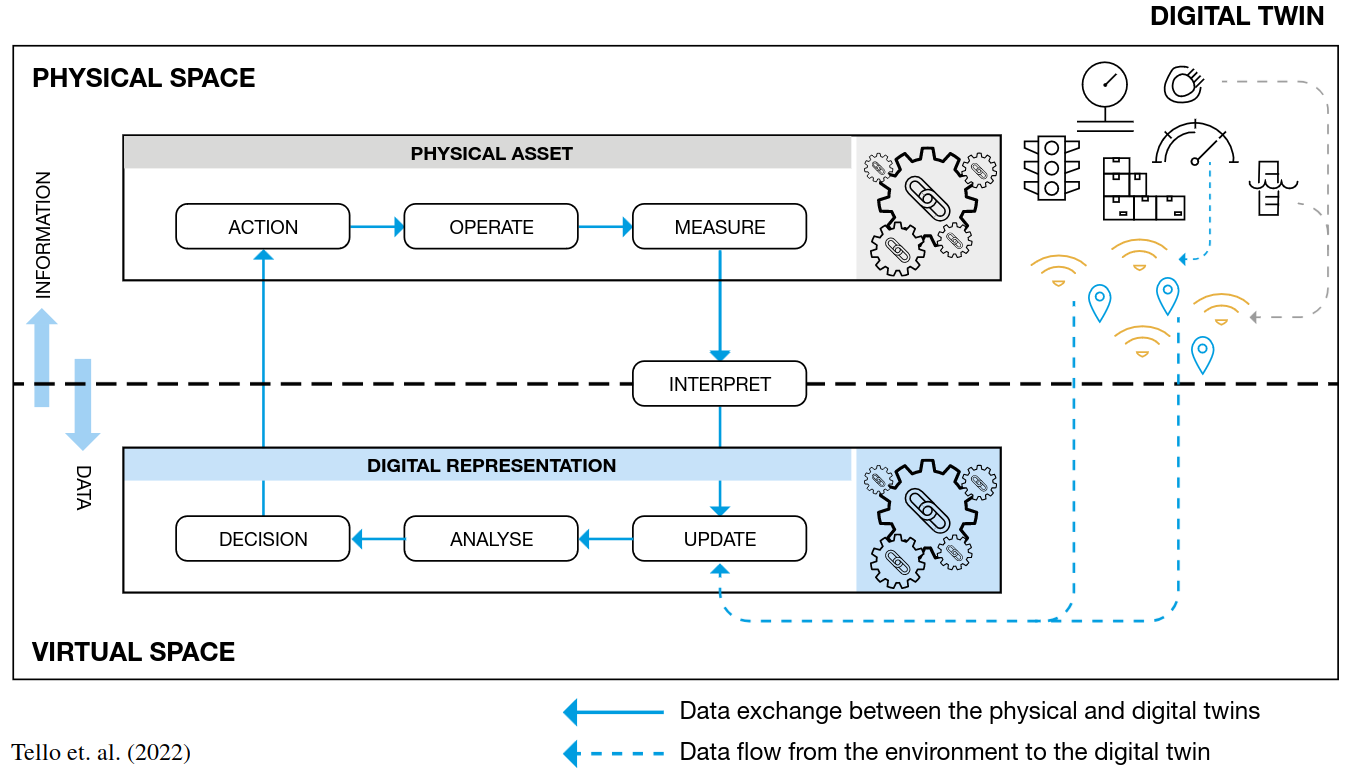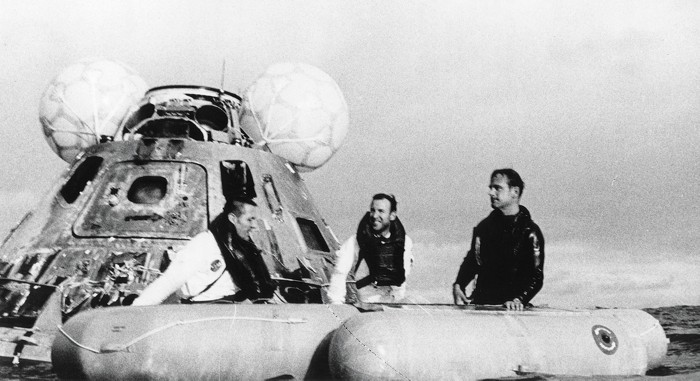Digital Twins

Digital Twins (of Physical Systems)
Date: 23.12.2023
TL;DR: With great simplicity, digital replica of a physical system with a bidirectional communication in between is referred as Digital Twins. They are not new, they are not simulations, and they are not just an Internet of Things (IoT) network. Digital Twins are becoming highly popular in the past 5 years, following the advancements in networking technologies (5G), deep learning, and the involvement of semantic technologies in smart environments in general. Semantics help with system/data modeling, interoperability, (implicit) relation extraction / learning, and reasoning in digital twins.
Table of Contents
Defining Digital Twins
… is hard as researchers came up with many definitions [1][6]. Proposing another definition that is a synthesis of others is not helpful. Instead, focusing on the commonalities of existing definitions can help understanding what they are. I see the following two as the most repeated points [2]:
- A continuous digital ‘replica’ of a physical system, that reflects physical reality as exact as possible.
- Bidirectional communication in between the physical system, aka Physical Twin (PT), and the digital twin.
The digital replica is created by interpreting the information about the physical system in the digital environment in a way that is easy to store and process. This includes metadata about both electronic and non-electronic physical parts of the system and its environment. It is often referred as Digital Shadow (DS).
![digital twins illustration taken from paper [2]](/assets/images/tello_dt.png)
Figure 1: Digital Twins illustration taken from [2]
Figure 1 illustrates both digital and physical ‘spaces’ together with the actions taken in each space. Both measurements and static metadata about the system is interpreted and the digital representation of the physical space is updated based on this interpretation. This is the main point of the first communication step, from PT to digital twin.
The second is that, digital representation can be used to run analysis, simulations and applications, e.g., machine learning applications, which result in a set of actions to be performed in the PT. This is based on the representation of the physical space. These actions can be towards making the physical system run more efficiently, mitigating problems in the physical system or just routine actions. This means that the digital twin can perform many tasks depending on the application and it is not characterized by certain set of applications.
Historical Background - ‘Houston, we have a problem!’
For most people, it is very surprising to hear that first digital twin, although it wasn’t called a digital twin at that time, is developed during the Apollo 13 mission, in 1970 [8]. The famous phrase “Houston, we have a problem” from Jim Lovell, was actually an emergency call from physical space to the digital space.
After an explosion in one of the oxygen tanks inside the service module of Apollo 13, astronauts contacted the mission control to inform them. The problem is diagnosed by the mission control thanks to the telemetry data that was continuously being sent to them. In order to find a new configuration that can bring the astronauts safely back earth, a simulation of the damaged spacecraft is run by the mission control.
This example still fits to the 2 common points of existing digital twin definitions described in the first part. There is digital representation of the physical environment, which is how the mission control knew what was happening in the spacecraft. And there is a bidirectional communication in between them, meaning that the mission control was able to help re-configure the spacecraft using the data received and simulations.

Figure 2: Apollo 13 landing. Image credit: NASA.
The next time when the digital twins are used without mentioning their current name is when Dr. Michael Grieves proposed a conceptual ideal for Product Lifecycle Management (PLM) [5], in 2002 for manufacturing domain: “PLM is an integrated, information driven approach to all aspects of a product’s life from its design inception, through its manufacture, deployment and maintenance, and culminating in its removal from service and final disposal”. In his presentation [5], Dr. Grieves clearly shows the separation of physical and digital space, and the bidirectional communication in between them.
Twinning Ratio
Based on the mentioned use cases and definitions, it is clear that having a highly representative interpretation of the physical space is crucial for digital twins. The more accurate the representation is, the more we can get out of digital twins. However, there is no quantitative method to measure the ‘representativeness’, this is what we call in our publication [3] as the “twinning ratio”.
We argued in our research that closer the digital representation to the PT is, more accurate the applications running on the digital twin will be. Meaning that if we fail to capture a certain part of reality in the digital space, our applications using this digital representation will be less accurate. We call this twinning ratio, a qualitative term that emphasizes the need for high ‘enough’ accuracy of the digital representation.
The hype around Digital Twins
Many of the surveys around digital twins [1][4] show that they are becoming more and more popular. To understand the reason, we can go back to the 2 initially mentioned common distinctive features of the digital twins; i) an accurate ‘enough’ continuous representation of the digital twin, ii) and a bidirectional communication in between them.
To establish an accurate continuous representation, we need the following 2 key technologies. The first is to have a semantic model of the digital twin together with the concepts from the physical environment. Recent survey [1] shows that researchers started working on this in the past 5 years only. Secondly, a fast and reliable sensor communication system to get updates from the physical environment. I believe this is also happening in the past 5 (or slightly more) years thanks to the advancements around 4G and 5G.
Digital Twins and Semantics
Physical systems and their environment can get highly complex. Semantic technologies such as ontologies and knowledge graphs can help modeling and implementing such complex systems. Ontologies however, can now be created much faster thanks to Large Language Models (LLMs) [9]. Although LLMs can not create an ontology from scratch, they can help ease the process enormously.
Besides system/data modeling, semantics can also help with interoperability, inferring implicit relations in between physical components, and facilitates learning and reasoning tasks [3,4]. Semantic interoperability makes data machine processable in and across digital twins. Using the semantic representation of the data, classical relation extraction algorithms and/or machine learning-based algorithms can be run to infer relations in between physical system subcomponents. Extracted/learned relations can then be used for semantic reasoning to make decisions on the physical system.
References
[1] R. D. D’Amico, J. A. Erkoyuncu, S. Addepalli, S. Penver, Cognitive digital twin: An approach to improve the maintenance management, CIRP Journal of Manufacturing Science and Technology 38 (2022) 613–630.
[2] A. Tello, V. Degeler, Digital Twins: An enabler for digital transformation, in: The Digital Transformation handbook, Groningen Digital Business Centre (GDBC), 2022. doi:10.5281/zenodo.7647493
[3] Karabulut, Erkan, Degeler, Victoria, and Groth, Paul. Semantic Association Rule Learning from Time Series Data and Knowledge Graphs. In SemIIM’23: 2nd International Workshop on Semantic Industrial Information Modelling co-located with 22nd International Semantic Web Conference (ISWC 2023).
[4] Karabulut, Erkan, Salvatore F. Pileggi, Paul Groth, and Victoria Degeler. Ontologies in digital twins: A systematic literature review. Future Generation Computer Systems (2023).
[5] M.Grieves, Completing the cycle: Using plm information in the sales and service functions. Conference: SME Management Forum (10 2002).
[6] Barricelli, Barbara Rita, Elena Casiraghi, and Daniela Fogli. A survey on digital twin: Definitions, characteristics, applications, and design implications. IEEE access 7 (2019): 167653-167671.
[7] NASA. Houston, we’ve got a problem. Accessed: November 17, 2023. Available online: Link.
[8] Stephen Ferguson. “Apollo 13: The First Digital Twin.” Available online: Link. Accessed: 23.12.2023.
[9] Babaei Giglou, Hamed, Jennifer D’Souza, and Sören Auer. LLMs4OL: Large Language Models for Ontology Learning. International Semantic Web Conference. Cham: Springer Nature Switzerland, 2023.